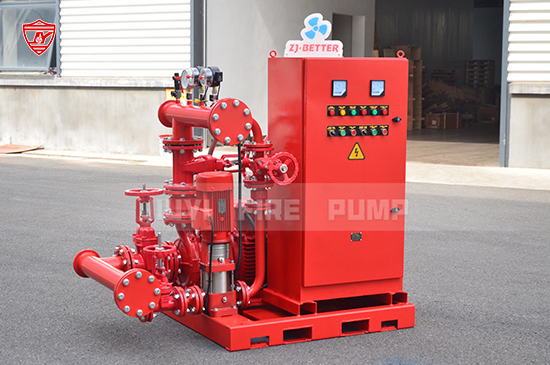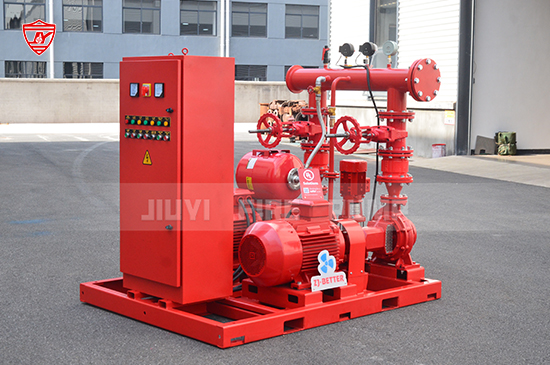Fire pumps are often idle for long periods—waiting for an emergency to occur. Without routine maintenance, internal wear, corrosion, battery failures, fuel issues, or misalignment can go unnoticed until it’s too late. Preventive maintenance:
Ensures code compliance (e.g., NFPA 25)
Improves pump reliability and lifespan
Reduces costly emergency repairs
Provides documented records for insurance and inspections
Enhances occupant safety in critical facilities like hospitals, warehouses, and high-rise buildings
Before diving into the checklist, follow these general principles:
Keep a maintenance logbook for every fire pump.
Follow the manufacturer’s manual in addition to NFPA 25 recommendations.
Assign trained personnel or certified contractors.
Ensure components are clean, lubricated, and free from leaks.

1. Visual Inspection:
Check the area around the pump for obstructions.
Look for any signs of leaks under or near the pump.
Ensure control panels and gauges are functional.
2. System Pressure:
Confirm the system pressure matches the set point.
Ensure gauges are calibrated and accurate.
1. Weekly No-Flow Test (Churn Test):
Run the pump automatically or manually for 10 minutes (diesel) or 30 minutes (electric).
Record RPM, pressure readings (suction/discharge), and amperage draw.
2. Check for Abnormalities:
Unusual noises or vibrations.
Loose connections or bolts.
Unusual smells (burnt oil, overheating).
3. Diesel Engine Pumps:
Check fuel level (minimum 2/3 full).
Inspect oil pressure and coolant levels.
Inspect battery voltage and charger operation.
4. Electric Fire Pumps:
Check phase voltage and amperage.
Inspect controller for power supply status.
1. Fire Pump Controller Checks:
Ensure all indicator lights and alarms work.
Test automatic start with simulated pressure drop.
Review event log for abnormal entries or missed starts.
2. Battery Maintenance (Diesel Pumps):
Clean battery terminals.
Check electrolyte levels.
Test specific gravity if applicable.
3. Check Pump Packing & Gland:
Ensure packing is not leaking excessively (about 10-60 drops/minute is typical).
Adjust as necessary.
1. Lubrication:
Lubricate bearings per manufacturer’s guidelines.
Grease electric motor or engine parts.
2. System Alarms & Supervisory Devices:
Test tamper switches, low-pressure alarms, and signal supervision.
Verify they transmit alarms correctly to the central monitoring station.
3. Check Fuel System (Diesel Pump):
Drain water and sediment from fuel tank and filters.
Confirm tank vent and overflow are clear.
1. Full Flow Performance Test (NFPA 25 8.3.7):
Conduct a flow test using test headers to measure:
No-flow (churn) pressure
100% flow (rated capacity)
150% flow (overload condition)
Record flow, pressure, voltage, and current readings.
2. Alignment Check:
Inspect shaft alignment between pump and driver.
Realign if there’s any sign of misalignment or vibration.
3. Internal Inspection:
Open casing and inspect impeller, bearings, and wear rings.
Check for corrosion or scaling.
4. Relief Valves and Pressure Regulators:
Test for proper operation and reset if necessary.
5. Diesel Engine Maintenance:
Replace engine oil, coolant, and filters.
Inspect belts, hoses, and mounts for wear.
6. Controller Testing:
Test all controller components, including circuit breakers, transfer switches, and battery charger circuits.

NFPA 25 mandates that all maintenance, testing, and inspections be documented. Your records should include:
Date and time of inspection or test
Name of person performing the work
Findings and corrective actions taken
Signature of responsible personnel
Test data (pressures, amperage, flow rates, etc.)
Neglecting Weekly Tests: Fire pumps should not be “install-and-forget.” Skipping weekly tests can lead to unseen issues.
Improper Lubrication: Over-lubricating or using the wrong grease can damage components.
Infrequent Flow Tests: Churn tests are not enough. Full-flow testing is necessary to ensure the pump meets its rated capacity.
Battery Neglect: Diesel fire pumps depend on battery health. Dead batteries are a top cause of fire pump failure.
Partner with a certified fire protection service provider for annual testing.
Upgrade older controllers to modern models with diagnostic capabilities.
Conduct fire drills involving the pump system to test real-world functionality.
Train on-site maintenance staff with refresher courses annually.
Fire pumps are the heart of a fire protection system—and like any vital organ, they need consistent care. This Fire Pump Preventive Maintenance Checklist provides a framework to keep your system compliant, reliable, and ready to protect lives and property when it matters most.
If you're looking for expert guidance or high-quality UL-listed fire pump packages, diesel fire pumps, electric fire pumps, or jockey pumps, Better Technology Group is here to support your fire protection needs.